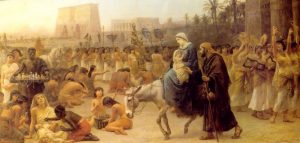
The Flight into Egypt, a well-known story about Jesus, Mary and Joseph, is one of the listed Seven Sorrows of Mary
It happened that some time after Jesus was born, than He began to be persecuted by Herod, who then ruled over the Jews. This ambitious prince, hearing that the long-expected Messiah has come into the world, was seized with envy and alarm. He feared that this Savior should supplant him in his authority and usurp his throne; therefore he sought to destroy him while he was yet a helpless babe.
When the wise men came to Jerusalem from the east, enquiring “Where is He who is born King of the Jews?”, Herod, thinking the time had arrived to rid himself of his supposed rival, called them privately, and learned from them at what time the star which guided them from the East had first appeared: then, sending them into Bethlehem, he said: “Go, and diligently enquire after the child; and when you have found Him, bring me word again, that I also may come and adore Him.” He hoped, by this deceitful stratagem, to obtain possession of the Child.
After the wise men had found Jesus, adored Him and presented before Him their choicest gifts of gold, frankincense and myrrh, they were warned by a token from God that they should not return to Herod. They therefore went back another way into their own country.
When the envious tyrant found that his plans were thus brought to nothing, like Pharaoh, King of Egypt, he formed the cowardly and savage design of slaying every male child in that part of the country from two years old and under. For he concluded, from what the Magi had told him, that the Messiah would surely be among the victims to his cruelty.
But after the Magi had departed, an angel of the Lord appeared in sleep to Joseph, saying: “Arise, and take the child and his mother, and fly into Egypt, and be there until I shall tell you; for it will come to pass that Herod will seek the child to destroy Him.”
What happened to the Holy Family on this perilous journey into Egypt? The Bible doesn’t say. Perhaps because of this omission, legends and lore soon sprouted up around the event.
According to one tale, Herod’s soldiers knew the Holy Family had escaped and so pursued them. As Mary, Joseph, and Jesus passed some peasants sowing wheat, Mary said to them, “If anyone should ask if we have been here, tell them that we indeed passed by while you were sowing this field of wheat.” Miraculously, the wheat sprouted and grew tall overnight. When Herod’s soldiers inquired of the peasants and learned that their prey had passed through the region at the time the wheat was planted, they figured that the Holy Family was many days ahead of them and so lost heart and returned to Judea.
An ancient document, known as the Arabic Infancy Gospel, records another near escape. In this story, the Holy Family is held up by bandits on their way to Egypt. One of the highwaymen, however, feels a special sympathy for the fugitives and refuses to rob them. In fact, he tries to convince the other robber to let them go. The other refuses until the first robber agrees to pay him a girdle and forty coins. The kind-hearted thief does so and the other reluctantly allows the prisoners to depart. The baby Jesus predicts that he and the bandits will die on the same day in the same place. Sure enough, according to the Arabic Infancy Gospel, these men turn out to be the two thieves, the one remorseful and the other not, who were crucified alongside Jesus about thirty years later (Luke 23:93-43).
Another tale, reports that the Holy Family passed through a forest on their long journey to Egypt. Every tree except the aspen bowed in reverence as they passed. Irritated by this lack of respect the baby Jesus then cursed the tree, which is why its leaves tremble in the wind till this day.
A local French tradition states that Saint Aphrodisius, an Egyptian saint who was venerated as the first bishop of Béziers, was the man who sheltered the Holy Family when they fled into Egypt.
It is also held that the Holy family visited many areas in Egypt including Farama, Tel Basta, Wadi El Natrun, Samanoud, Bilbais, Samalout, Maadi, Al-Maṭariyyah[16] and Asiut among others.
It is also tradition that the Holy Family visited Coptic Cairo and stayed at the site of Saints Sergius and Bacchus Church (Abu Serga) and the place where the Church of the Holy Virgin (Babylon El-Darag) stands now.
At Al-Maṭariyyah, then in Heliopolis and now part of Cairo, there is a sycamore tree (and adjacent chapel) that is a 1672 planting replacing an earlier tree under which Mary was said to have rested, or in some versions hidden from pursuers in the hollow trunk, while pious spiders covered the entrance with dense webs.
The Flight into Egypt was also a popular subject in art, showing Mary with the baby on a donkey, led by Joseph. Some artists include Henry Ossawa Tanner (1923), Edwin Long (1883), and others.
For more information on the flight into Egypt, go to (udayton.edu/lmrl/mary/f/flight-into-egypt.php).
